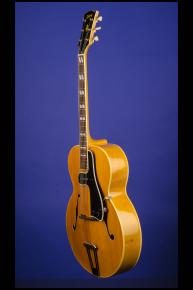Gibson's Most Successful 17-Inch Archtop - Essentially a Plain Version of the L-5
The Only Example Shipped in 1953
The only natural L-7CE shipped in 1953. This sixty-six year old L-7E 'McCarty' weighs just 5.30 lbs and features a seventeen inch wide, 3 3/8 inches deep body with a hand-carved book-matched solid spruce top, one-piece highly-flamed maple back, solid lightly-flamed maple sides and two 'f' holes with the edges painted white. Two-piece lightly-flamed maple neck with mahogany center-strip. Brazilian rosewood fretboard with 20 original medium frets and inlaid pearl double-parallelogram position markers. The body is triple-bound, the fretboard and headstock are single-bound. Headstock with inlaid pearl "Gibson" logo and pearl crown inlay. Single-layer black plastic truss-rod cover with two screws. Black laminate 'stinger' on the back of the headstock. Individual 'no-name' Kluson Deluxe tuners with single-ring Keystone plastic buttons (stamped on the underside "2356766 / Pat Appld."). Original Gibson 'McCarty' single-coil pickup (with an output of 6.16k) with non-adjustable, flat pole pieces mounted into a five layer black over white plastic laminated pickguard together with one volume and one tone control and a screw-on type input jack. Black plastic circular knobs (9/16 inch in diameter, 5/16 inches tall) with ribbed sides. Height-adjustable frequensated rosewood bridge on rosewood base. Standard trapeze tailpiece with three raised parallelograms on cross-bar, secured to lower edge of body by three screws. Original oval white label inside the bass f-hole with the Style "L-7" written in blue ink and the serial number A-"15857" stamped in black. There are a few very small and insignificant surface marks on the body - the most significant being just to the treble-side of the treble 'f' hole and there is some fine finish checking on the back. The original medium frets show very little wear and the fret-board has no divots. This fine sixty-six year old jazz masterpiece has been stored for the past thirty years plus and is in near mint (9.25) condition. Complete with the original 'McCarty' pickup lead. Housed in the original Gibson f'ive-latch' shaped brown hardshell case with pink plush lining (9.00).
A total of just thirteen L-7NEs were shipped between 1950 and 1954. The shipping numbers are as follows:
1950:4; 1951:6; 1952:1; 1953:1; 1954:1.
"The basic finish of the "electrified" L-7's was initially (and only) the traditional sunburst, but in 1950, a "natural" option was also offered for each model, until their discontinuation in 1954." (Gibson Electrics. A.R. Duchossoir, p.41).
"In 1948 Ted McCarty joined the Gibson company, and one of his first priorities was to expand the potential number of Gibson's electric guitar models in a quick and inexpensive way. He invented an ingenious pickup/pickguard assembly known now as the McCarty pickup, consisting of a very thin single-coil pickup with non-adjustable, flat pole pieces mounted into a laminated pickguard along with volume and tone controls and an input jack. The McCarty pickup assembly was offered in single - and double - pickup versions, for cutaway and non cutaway guitars, and for guitars with nickel-plated parts and gold-plated parts. The pickup was officially introduced on the L-7 guitar as an option, and these early electric L-7s were labeled the L-7E or the L-7PE, with the letter E designating their electric status, while P indicated Premiere, or cutaway, body style. In reality, these were stock L-7 guitars that had the McCarty pickup assembly supplied with them at the factory instead of a conventional acoustic pickguard."
Originally introduced in 1948 as a 'plain' version of the L-5. "Extremely popular for orchestra use, the L-7C with its modern cutaway design has outstanding appearance and an unusually rich tone. Gibson quality, exclusive features, and expert workmanship insure perfection in every detail of construction. Attractive alternate white-black-white ivoroid binding - hand graduated carved top of selected spruce, arched curly maple back with matching curly maple rims. Three piece curly maple neck, with adjustable Truss Rod construction - bound rosewood fingerboard with attractive parallel pearl inlay design. Nickel-plated metal parts, Gibson designed tailpiece, laminated pickguard with attractive border, rosewood adjustable bridge, and enclosed individual machine heads with deluxe buttons." (1957-8 Gibson catalog).












